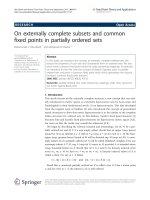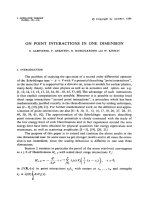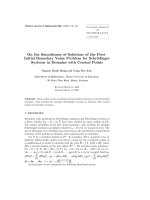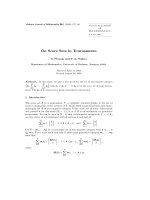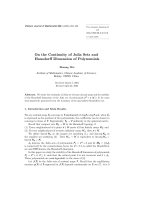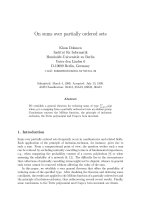Báo cáo toán học: " On Score Sets in Tournaments" pptx
Bạn đang xem bản rút gọn của tài liệu. Xem và tải ngay bản đầy đủ của tài liệu tại đây (88.02 KB, 5 trang )
Vietnam Journal of Mathematics 34:2 (2006) 157–161
On Score Sets in Tournaments
S. Pirzada and T. A. Naikoo
Department of Mathematics, University of Kashmir, Srinagar, India
Received April 14, 2005
Revised August 26, 2005
Abstract. In this paper, we give a new proof for the set of non-negative integers
s
1
,
2
i=1
s
i
, ,
p
i=1
s
i
with s
1
<s
2
< ··· <s
p
to be the score set of some tourna-
ment. The proof is constructive, using tournament construction.
1. Introduction
The score set S of a tournament T , a complete oriented graph, is the set of
scores (outdegrees) of the vertices of T. In [5], Reid conjectured that each finite,
nonempty set S of non-negative integers is the score set of some tournament
and proved it for the cases |S| =1, 2, 3, or if S is an arithmetic or geometric
progression. As can b e seen in [2 – 4] that non-negative integers s
1
s
n
are the scores of a tournament with n vertices if and only if
k
i=1
s
i
≥
k
2
, 1 k n − 1, and
n
i=1
s
i
=
n
2
.
Let S = {t
1
, ,t
p
} be a nonempty set of non-negative integers with t
1
< <
t
p
, then S is a score set if and only if there exist p positive integers m
1
, ,m
p
such that
k
i=1
m
i
t
i
≥
M (k)
2
, 1 k p − 1,
p
i=1
m
i
t
i
=
M (p)
2
,
where
M (k)=
k
i=1
m
i
, 1 k p,
158 S. Pirzada and T. A. Naikoo
because only the inequalities in the above mentioned formula for those values of
k,forwhichs
k
<s
k+1
hold, need to be checked [5, p.608].
The following results can be seen in [5].
Theorem 1. Every singleton or doubleton set of positive integers is the score
set of some tournament.
Theorem 2. Let S = {s, sd, sd
2
, ,sd
p
},wheres and d are positive integers,
d>1. Then, there exists a tournament T such that S
T
= S.
Theorem 3. Let S = {s, s+ d, s+2d, ,s+pd},wheres and d are n on-negative
integers, d>0. Then, there is a tournament T such that S
T
= S.
Theorem 4. Let S = {s, s + d, s + d + e},wheres, d,ande are non-negative
integers and de > 0.Let(d, e)=g .Ifd s and e s + d −
d
2g
+
1
2
, then S
is a sco re set.
Theorem 5. Let S = {s, s + d, s + d + e},wheres, d,ande are non-negative
integers and de > 0.Let(d, e)=g.Ifd s and s−d+
d
2g
+
1
2
<e s+d−1,
then S is a score set.
Theorem 6. Every set of three non-negative integers is a score set.
Also the following results can be found in [1].
Theorem 7. Let s
1
,s
2
,s
3
,s
4
be four non-negative integers with s
2
s
3
s
4
> 0.
Then, ther e exists a tournament T with sc ore set S = {s
1
,s
1
+ s
2
,s
1
+ s
2
+
s
3
,s
1
+ s
2
+ s
3
+ s
4
}.
Theorem 8. Let s
1
,s
2
,s
3
,s
4
,s
5
be five non-negative integers with s
2
s
3
s
4
s
5
> 0.
Then, there exists a tournament T with score set S = {s
1
,s
1
+s
2
,s
1
+s
2
+s
3
,s
1
+
s
2
+ s
3
+ s
4
,s
1
+ s
2
+ s
3
+ s
4
+ s
5
}.
In 1986, Yao announced a proof of Reid’s conjecture by pure arithmetical
analysis which appeared in Chinese [6] in 1988 and in English [7] in 1989.
In the following result, we prove that any set of p non-negative integers
s
1
,s
2
, ,s
p
with s
1
<s
2
< < s
p
, there exists a tournament with score set
s
1
,
2
i=1
s
i
, ,
p
i=1
s
i
. The proof is by induction using graph theoretical technique
of constructing tournament.
Theorem 9. If s
1
,s
2
, ,s
p
are p non-negative integers with s
1
<s
2
< <
s
p,
then there exists a tournament T with score set S =
s
1
,
2
i=1
s
i
, ,
p
i=1
s
i
.
Proof. Let s
1
,s
2
, ,s
p
be p non-negative integers with s
1
<s
2
< < s
p
.
We induct on p. First a ssume p to be odd. For p = 1, we have the non-negative
On Score Sets in Tournaments 159
integer s
1
, and now, let T be a regular tournament having 2s
1
+1 vertices. Then,
each vertex of T has score
2s
1
+1−1
2
= s
1
,sothatscoresetofT is S = {s
1
}.This
shows that the result is true for p =1.
If p = 3, then there are three non-negative integers s
1
,s
2
,s
3
with s
1
<s
2
<
s
3
.
Now, s
3
>s
2
, therefore s
3
− s
2
> 0, so that s
3
− s
2
+ s
1
> 0ass
1
≥ 0.
Let T
1
be a regular tournament having 2(s
3
− s
2
+ s
1
) + 1 vertices. Then, each
vertex of T
1
has score
2(s
3
−s
2
+s
1
)+1−1
2
= s
3
− s
2
+ s
1
.
Again, since s
2
>s
1
, therefore s
2
−s
1
> 0, so that s
2
−s
1
−1 ≥ 0. Let T
2
be a
regular tournament having 2(s
2
−s
1
−1)+1 vertices. Then, each vertex of T
2
has
score
2(s
2
−s
1
−1)+1−1
2
= s
2
− s
1
− 1. Also, s
1
≥ 0, let T
3
be a regular tournament
having 2s
1
+ 1 vertices. Then, each vertex of T
3
has score
2s
1
+1−1
2
= s
1
.
Let every vertex of T
2
dominate each vertex of T
3
, and every vertex of T
1
dominate each vertex of T
2
and T
3
, so that we get a tournament T having
2s
1
+1+2(s
2
− s
1
− 1)+1+2(s
3
− s
2
+ s
1
)+1=2(s
1
+ s
3
) + 1 vertices with
score set
S =
s
1
,s
2
− s
1
− 1+2s
1
+1,s
3
− s
2
+ s
1
+2(s
2
− s
1
− 1)+1+2s
1
+1
=
s
1
,
2
i=1
s
i
,
3
i=1
s
i
.
This shows that the result is true for p =3also.
Assume, the result to be true for all odd p.Thatis,ifs
1
,s
2
, ,s
p
be p
non-negative integers with s
1
<s
2
< < s
p
, then there exists a tournament
having 2(s
1
+ s
3
+ + s
p
) + 1 vertices with score set
s
1
,
2
i=1
s
i
, ,
p
i=1
s
i
.We
show the result is true for p +2.
Let s
1
,s
2
, ,s
p+2
be p +2 non-negative integers with s
1
<s
2
< <s
p+2
.
This implies that s
1
<s
2
< < s
p
. T herefore, by induction hypothesis, there
exists a tournament T
1
having 2(s
1
+ s
3
+ + s
p
) + 1 vertices with score set
s
1
,
2
i=1
s
i
, ,
p
i=1
s
i
.
Since, s
2
>s
1
,s
4
>s
3
, ,s
p−1
>s
p−2
,s
p+1
>s
p
, therefore s
2
−s
1
> 0,s
4
−
s
3
> 0, ,s
p−1
−s
p−2
> 0,s
p+1
−s
p
> 0, so that s
p+1
−s
p
+s
p−1
−s
p−2
+ +
s
4
−s
3
+s
2
−s
1
> 0, that is, s
p+1
−s
p
+s
p−1
−s
p−2
+ +s
4
−s
3
+s
2
−s
1
−1 ≥ 0.
Let T
2
be a regular tournament having 2(s
p+1
− s
p
+ s
p−1
− s
p−2
+ + s
4
−
s
3
+ s
2
− s
1
− 1) + 1 vertices. Then, each vertex of T
2
has score
2(s
p+1
− s
p
+ s
p−1
− s
p−2
+ ···+ s
4
− s
3
+ s
2
− s
1
− 1) + 1 − 1
2
= s
p+1
− s
p
+ s
p−1
− s
p−2
+ ···+ s
4
− s
3
+ s
2
− s
1
− 1 .
Again, s
3
>s
2
, ,s
p
>s
p−1
,s
p+2
>s
p+1
, therefore s
3
−s
2
> 0, ,s
p
−s
p−1
>
0,s
p+2
− s
p+1
> 0, so that
s
p+2
− s
p+1
+ s
p
− s
p−1
+ + s
3
− s
2
+ s
1
> 0ass
1
≥ 0.
160 S. Pirzada and T. A. Naikoo
Let T
3
be a regular tournament having
2(s
p+2
− s
p+1
+ s
p
− s
p−1
+ + s
3
− s
2
+ s
1
)+1
vertices. Then, each vertex of T
3
has score
2(s
p+2
− s
p+1
+ s
p
− s
p−1
+ ···+ s
3
− s
2
+ s
1
)+1− 1
2
= s
p+2
− s
p+1
+ s
p
− s
p−1
+ ···+ s
3
− s
2
+ s
1
.
Let every vertex of T
2
dominate each vertex of T
1
, and every vertex of T
3
dominate each vertex of T
1
and T
2
, so that we get a tournament T having
2(s
1
+ s
3
+ ···+ s
p
)+1+2(s
p+1
–s
p
+ s
p–1
–s
p–2
+ ···+ s
4
–s
3
+ s
2
–s
1
–1) + 1
+2(s
p+2
–s
p+1
+s
p
–s
p−1
+ ···+s
3
–s
2
+s
1
)+1 = 2(s
1
+ s
3
+ ···+ s
p+2
)+1
vertices with score set
S =
s
1
,
2
i=1
s
i
, ,
p
i=1
s
i,
s
p+1
− s
p
+ s
p−1
−···+ s
4
− s
3
+ s
2
− s
1
− 1
+2(s
1
+ s
3
+ ···+ s
p−2
+ s
p
)+1,s
p+2
− s
p+1
+ s
p
− s
p−1
+ ···+ s
3
− s
2
+ s
1
+2(s
1
+s
3
+ ···+s
p−2
+s
p
)+1+2(s
p+1
–s
p
+ s
p–1
– ···+s
4
–s
3
+ s
2
–s
1
–1) + 1
=
s
1
,
2
i=1
s
i
, ,
p
i=1
s
i
,
p+1
i=1
.
This shows that the result is true for p + 2 also. Hence, by induction, the result
is true for all odd p.
To prove the result for even case, if p is odd, then p + 1 is even.
Let s
1
,s
2
, ,s
p+1
be p +1 non-negative integers with s
1
<s
2
< <s
p+1.
Therefore, s
1
<s
2
< < s
p
,wherep is odd. Then, by above case, ther e
exists a tournament T
1
having 2(s
1
+ s
3
+ + s
p
) + 1 vertices with score set
s
1
,
2
i=1
s
i
, ,
p
i=1
s
i
.
Also, since s
2
>s
1
,s
4
>s
3
, ,s
p−1
>s
p−2
,s
p+1
>s
p,
then as above, we
have a regular tournament T
2
having 2(s
p+1
− s
p
+ s
p−1
− s
p−2
+ + s
4
− s
3
+
s
2
− s
1
− 1) + 1 vertices and score for each vertex is
s
p+1
− s
p
+ s
p−1
− s
p−2
+ ···+ s
4
− s
3
+ s
2
− s
1
− 1 .
Let every vertex of T
2
dominate each vertex of T
1
, so that we get a tourna-
ment T having
2(s
1
+ s
3
+ ···+ s
p−2
+ s
p
)+1+2(s
p+1
− s
p
+ s
p−1
− s
p−2
+ ···+ s
4
− s
3
+ s
2
− s
1
− 1) + 1 = 2(s
2
+ s
4
+ ···+ s
p+1
)
vertices with score set
On Score Sets in Tournaments 161
S =
s
1
,
2
i=1
s
i
, ,
p
i=1
s
i
,s
p+1
− s
p
+ s
p−1
− s
p−2
+ ···+ s
4
− s
3
+ s
2
− s
1
− 1
+2(s
1
+ s
3
+ ···+ s
p−2
+ s
p
)+1
=
s
1
,
2
i=1
s
i
, ,
p
i=1
s
i
,
p+1
i=1
s
i
.
This shows that the result is true for even also. Hence, the result.
Remark. In the proof of Theorem 9, we note that when p is odd, the tournament
T constructed with score set S =
s
1
,
2
i=1
s
i
, ,
p
i=1
s
i
,wheres
1
<s
2
< ···<s
p
,
has 2(s
1
+s
3
+ +s
p
)+1 vertices; and when p is even the tournament constructed
has 2(s
2
+ s
4
+ + s
p+1
) vertices.
Acknowledgements.
The authors thank the anonymous referee for his valuable sug-
gestions.
References
1. M. Hager, On score sets for tournaments, J. Discrete Math. 58(1986) 25–34.
2. H. G. Landau, On dominance relations and the structure of animal societies, III,
the condition for a score structure, Bull. Math. Biophys. 15 (1953) 143–148.
3. J. W. Moon, Topics on Tournaments Halt, Rinehart and Winston, New York,
1968.
4. K. B. Reid and L. W. Beineke, Tournaments, Selected Topics in Graph Theory,
L.W. Beineke and R.J. Wilson, (Eds.), Academic Press, New York, 1979.
5. K. B. Reid, Score sets for tournaments, Congressus Numerantium XXI, Proceed-
ings of the Ninth Southeastern Conference on Combinatorics, Graph Theory, and
Computing, 1978, 607–618.
6. T. X. Yao, Reid’s conjecture on score sets in tournaments, Kexue Tongbao 33
(1988) 481–484 (in Chinese).
7. T. X. Yao, On Reid’s conjecture of score sets for tournaments, Chinese Sci. Bull.
34 (1989) 804–808.
